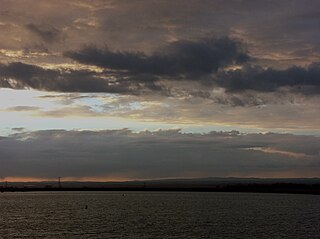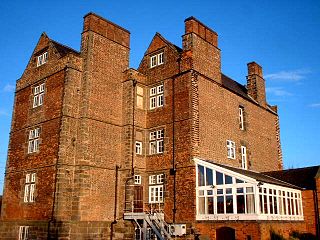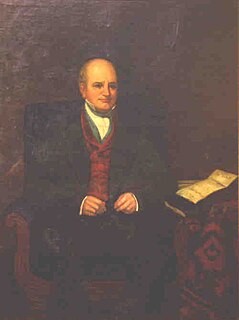Joseph Greaves was a High Sheriff of Derbyshire in 1765.

This is a list of High Sheriffs of Derbyshire from 1567.
Joseph Greaves was a High Sheriff of Derbyshire in 1765.

This is a list of High Sheriffs of Derbyshire from 1567.
Greaves was the son of another Joseph Greaves from Ingleby and Foremark who has bought purchased land in Aston-on-Trent in Derbyshire. It was his father who had commissioned the building of Aston Lodge. [1] This 2 1⁄2-storey building stood in its own grounds behind wrought iron gates by the ironsmith Robert Bakewell. [2]

Ingleby is a hamlet and civil parish in South Derbyshire, England. Situated on the south of the River Trent on a rise between Stanton by Bridge and Repton, Ingleby contains the privately owned John Thompson public house and the Ingleby Art Gallery.

Foremark is a hamlet and civil parish in the South Derbyshire district of Derbyshire, England. It contains Foremarke Hall, a medieval manor house which now houses Repton Preparatory School; and part of Foremark Reservoir.

Aston-on-Trent is a village and civil parish in the South Derbyshire district, in the county of Derbyshire, England. The parish had a population of 1,682 at the 2011 Census. It is adjacent to Weston-on-Trent and near Chellaston, very close to the border with Leicestershire.
When Greaves' father died in 1749 he inherited the large five-by-three-bay house which was then less than twenty years old. Greaves married Ann Boothby from Ashbourne, the sister of Sir Brook Boothby. [3] Greaves was a High Sheriff of Derbyshire in 1765.

Sir Brooke Boothby, 6th Baronet was a linguist, translator, poet and landowner, based in Derbyshire, England. He was part of the intellectual and literary circle of Lichfield, which included Anna Seward and Erasmus Darwin. In 1766 he welcomed the philosopher Jean-Jacques Rousseau to Ashbourne circles, after Rousseau's short stay in London with Hume. Ten years later, in 1776, Boothby visited Rousseau in Paris, and was given the manuscript of the first part of Rousseau's three-part autobiographic Confessions. Boothby translated the manuscript and published it in Lichfield in 1780 after the author's death, and donated the document to the British Library in 1781.
On his death he left his lands to his wife Ann. [3]

Derbyshire is a county in the East Midlands of England. A substantial portion of the Peak District National Park lies within Derbyshire, containing the southern extremity of the Pennine range of hills which extend into the north of the county. The county contains part of the National Forest, and borders on Greater Manchester to the northwest, West Yorkshire to the north, South Yorkshire to the northeast, Nottinghamshire to the east, Leicestershire to the southeast, Staffordshire to the west and southwest and Cheshire also to the west. Kinder Scout, at 636 metres (2,087 ft), is the highest point in the county, whilst Trent Meadows, where the River Trent leaves Derbyshire, is its lowest point at 27 metres (89 ft). The River Derwent is the county's longest river at 66 miles (106 km), and runs roughly north to south through the county. In 2003 the Ordnance Survey placed Church Flatts Farm at Coton in the Elms as the furthest point from the sea in Great Britain.

Buxton is a spa town in Derbyshire, in the East Midlands region of England. It has the highest elevation – about 1,000 feet (300 m) above sea level – of any market town in England. Close to the county boundary with Cheshire to the west and Staffordshire to the south, Buxton is described as "the gateway to the Peak District National Park". A municipal borough until 1974, Buxton was then merged with other localities lying primarily to the north, including Glossop, to form the local government district and borough of High Peak within the county of Derbyshire. Despite being in the East Midlands, economically Buxton is within the sphere of influence of Greater Manchester. The population of the town was 22,115 at the 2011 Census.

Shardlow is a village in Derbyshire, England about 6 miles (9.7 km) southeast of Derby and 11 miles (18 km) southwest of Nottingham. Part of the civil parish of Shardlow and Great Wilne, and the district of South Derbyshire, it is also very close to the border with Leicestershire, defined by route of the River Trent which passes close to the south. Just across the Trent is the Castle Donington parish of North West Leicestershire.

Weston-on-Trent is a village and civil parish in the South Derbyshire district of Derbyshire. The population of the civil parish at the 2011 census was 1,239. It is to the north of the River Trent and the Trent and Mersey Canal. Nearby places include Aston-on-Trent, Barrow upon Trent, Castle Donington and Swarkestone.

Great Wilne is a small village in Derbyshire, England on the border with Leicestershire. It is 7 miles (11 km) south east of Derby. It is a village split from its church of St Chad's by the river. The church is at the very small hamlet of Church Wilne which can only be approached by a short walk via the bridge over the River Derwent, or by a fair car journey which necessitates travelling out of the county. The population at the 2011 Census is included in the civil parish of Shardlow and Great Wilne.

Morley is a village and civil parish within the area of Erewash Borough Council in the English county of Derbyshire, north of Derby.

Joseph Strutt (1765–1844) was an English businessman and philanthropist, whose wealth came from the family textile business. A native of Derby, Strutt was a radical social reformer who made significant donations and founded several important institutions in the town, including donating the land for the creation of Derby Arboretum, England's first urban public park. He twice served as Mayor of Derby.

Sir Aston Cockayne, 1st Baronet (1608–1684) was, in his day, a well-known Cavalier and a minor literary figure, now best remembered as a friend of Philip Massinger, John Fletcher, Michael Drayton, Richard Brome, Thomas Randolph, and other writers of his generation.

Catton Hall is a country house near the boundary between Derbyshire and Staffordshire. It gives its postal address as Walton-on-Trent although there was a village of Catton at one time. It is a Grade II* listed building.

There have been two baronetcies created for persons with the surname Boothby, both in the Baronetage of England. One creation is extant as of 2008.

Smalley is a village on the main A608 Heanor to Derby road in Derbyshire in the East Midlands of England. The population of the civil parish as of the 2011 census was 2,784.

Edward Anthony Holden was a landowner who lived at Aston Hall, in Aston upon Trent, Derbyshire. He inherited land and bought more starting in 1833. He was High Sheriff of Derbyshire in 1838/9. By the time of his death he had created an estate of over 2,000 acres (8.1 km2) of land in Derbyshire and Leicestershire.
George Moore (1811–1871) was a landowner who became the High Sheriff of Derbyshire and built Appleby Hall in Leicestershire.
Thomas Levett-Prinsep (1800/1–1849), born Thomas Levett, was an English landowner in Derbyshire and Staffordshire. He took on the additional name of Prinsep on inheriting his uncle's holding of Croxall Hall.

Aston Hall is an 18th-century country house, now converted to residential apartments, at Aston-on-Trent, Derbyshire. It is a Grade II* listed building.

James Sutton was an English boatbuilder, canal boat carrier and owner of salt works. He became High Sheriff of Derbyshire.
William Drury-Lowe (1802–1877) was an English landowner who inherited the Locko Park lands and became a High Sheriff of Derbyshire.
Ashbourne Hall is a Manor house originally built by the Cockayne family in the 13th century in Ashbourne, Derbyshire. The present building is part of a largely demolished, Georgian-styled hall built in the 18th century.